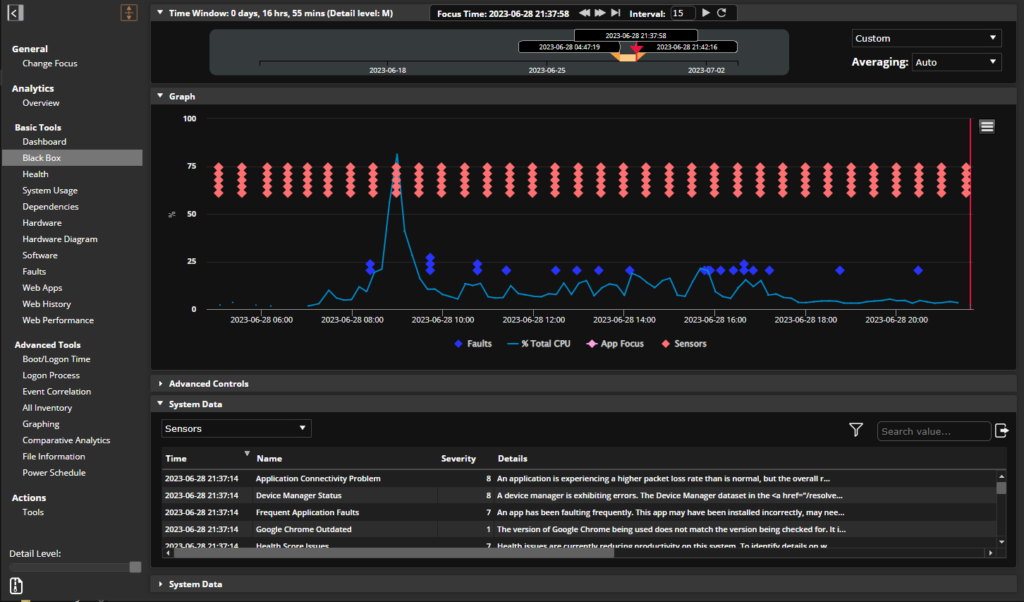
Artificial intelligence is transforming IT operations.
By applying machine learning and analytics to big data, IT departments can automate their processes and improve service delivery. That’s the key to building proactive operations and delivering better digital experience.
Key Components of AI for IT Operations
AIOps stands for artificial intelligence for IT operations. AIOps tools automate processes and tasks, such as application performance monitoring and root cause analysis. The goal is to improve IT service delivery via:
Scalable Data Aggregation
AIOps aggregates data from multiple sources and different collection methods, breaking down IT silos such as network infrastructure and application management.
Data Analysis
AIOps analyzes and contextualizes massive amounts of real time and historical data to deliver meaningful insights. As a result, it can:
- Correlate events to find patterns
- Detect anomalies
- Monitor the availability and performance of apps
- Identify root causes of problems more quickly
- Predict future incidents
Automated Remediation
AIOps can also take actions based on data. It’s possible to generate a recommendation, trigger an alert or automate a response. Automated resolution helps with service desk optimization because it minimizes the occurrence of common incidents requiring technicians’ intervention.
Lakeside Software’s Mike Flannigan and Jason Coari discuss key IT challenges in healthcare and how digital experience management can help during a recent webinar. (Watch the full session on demand here.)
Adoption of AIOps Platforms Is on the Rise
Trends of digital transformation and proactive IT drive the demand for AIOps solutions that automate processes and filter information.
Digital Transformation
With the rapid growth in data sources and volume, it’s impossible for humans to analyze manually the sheer amount of data that IT infrastructure and applications generate.
Proactive IT Support
More organizations are shifting their support desk from being reactive to IT issues to taking a more proactive role in order to minimize operational costs and enhance employee digital experience. The idea is to solve problems before they impact user productivity.
Benefits of AIOps Solutions
One of the main benefits of AIOps is its ability to digest large and diverse datasets quickly and provide actionable analytics. As a result, the IT operations team becomes more agile.
Here are specific ways in which AIOps improves IT efficiency:
- By resolving issues quickly, it’s possible to reduce mean time to resolution (MTTR) and downtime.
- Preventing issues from happening contributes to lower help desk ticket volumes.
- Quicker resolution and automated remediation save time and support costs, freeing IT staff to focus on higher-priority tasks.
More efficient IT support leads to better digital experience and employee engagement because end users spend less time experiencing technology-related issues that impact their productivity.
Faster and more accurate data-driven insights also enhance business decision-making. Better asset optimization is an example of that. Organizations can right-size software licensing and procure new hardware based on actual user needs rather than usual refresh cycles.
Maximize Digital Experience with AIOps Automation
AIOps is critical to effective digital experience management (DEM).
Lakeside Software’s research indicates that, for IT teams, improved automation is precisely one of the most valuable tools for enhancing digital experience. For the surveyed IT staff, self-service, proactive incident resolution, and self-healing are the most useful capabilities to automate IT service operations.
DEM platforms — such as Lakeside Software’s Digital Experience Cloud, powered by SysTrack — give visibility into the entire IT environment via endpoint monitoring, data-driven analytics, and automated remediation.
Lakeside Prevent Transforms End-User Data into Actionable Insights
Lakeside combines AIOps with endpoint monitoring to surface insights that help IT teams to solve issues quickly and prevent incidents from happening. Our cloud-based platform collects telemetry data from over 10,000 points every 15 seconds at the edge and then uses artificial intelligence to analyze all this data and offer insights into improving digital experience.
The SysTrack engine is powered by sensors that monitor users and applications in real-time and alert the IT team when an anomaly is detected or a threshold is reached.
Lakeside Prevent provides an overview of sensors, allowing IT teams to prioritize issues, dig further into details, and take automated actions.
For example, a sensor can be triggered if an application is consuming an excessive amount of resources. The technician can see which users are being affected by the same issue and take proactive steps to fix the problem before more employees complain.
This type of measure contributes to reducing the number of tickets and, consequently, lowering service desk costs — a key performance indicator (KPI) for IT success.
Shift Left with AIOps
Proactive IT operations introduce the concept of Level 0 support as part of a shift left approach in IT service management (ITSM). The purpose is to remediate issues before they require the attention of Level 1 technicians.
This strategy has been successfully implemented by glass manufacturer Şişecam Group. This company previously had a reactive approach to solving IT issues, relying on user reviews and support requests. By deploying Lakeside’s Digital Experience Cloud, Şişecam was able to measure performance on the endpoint to solve issues proactively and improve user satisfaction.
“As part of our continuous goal of efficiently running all of our desktops with sustainable performance, we use SysTrack to monitor performance but also for end-user behavior analysis.”
Neslihan Erdoğan
Şişecam Technology Development Specialist
Subscribe to the Lakeside Newsletter
Receive platform tips, release updates, news and more



